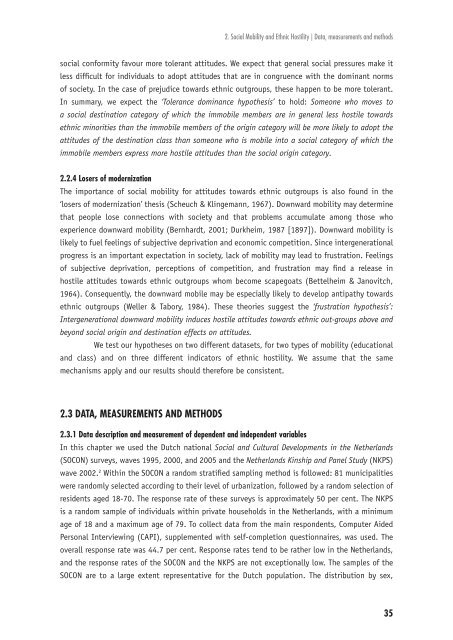Ethnic Hostility among Ethnic Majority and Minority Groups
Ethnic Hostility among Ethnic Majority and Minority Groups
Ethnic Hostility among Ethnic Majority and Minority Groups
You also want an ePaper? Increase the reach of your titles
YUMPU automatically turns print PDFs into web optimized ePapers that Google loves.
social conformity favour more tolerant attitudes. We expect that general social pressures make it<br />
less diffi cult for individuals to adopt attitudes that are in congruence with the dominant norms<br />
of society. In the case of prejudice towards ethnic outgroups, these happen to be more tolerant.<br />
In summary, we expect the ‘Tolerance dominance hypothesis’ to hold: Someone who moves to<br />
a social destination category of which the immobile members are in general less hostile towards<br />
ethnic minorities than the immobile members of the origin category will be more likely to adopt the<br />
attitudes of the destination class than someone who is mobile into a social category of which the<br />
immobile members express more hostile attitudes than the social origin category.<br />
2.2.4 Losers of modernization<br />
The importance of social mobility for attitudes towards ethnic outgroups is also found in the<br />
‘losers of modernization’ thesis (Scheuch & Klingemann, 1967). Downward mobility may determine<br />
that people lose connections with society <strong>and</strong> that problems accumulate <strong>among</strong> those who<br />
experience downward mobility (Bernhardt, 2001; Durkheim, 1987 [1897]). Downward mobility is<br />
likely to fuel feelings of subjective deprivation <strong>and</strong> economic competition. Since intergenerational<br />
progress is an important expectation in society, lack of mobility may lead to frustration. Feelings<br />
of subjective deprivation, perceptions of competition, <strong>and</strong> frustration may fi nd a release in<br />
hostile attitudes towards ethnic outgroups whom become scapegoats (Bettelheim & Janovitch,<br />
1964). Consequently, the downward mobile may be especially likely to develop antipathy towards<br />
ethnic outgroups (Weller & Tabory, 1984). These theories suggest the ‘frustration hypothesis’:<br />
Intergenerational downward mobility induces hostile attitudes towards ethnic out-groups above <strong>and</strong><br />
beyond social origin <strong>and</strong> destination effects on attitudes.<br />
We test our hypotheses on two different datasets, for two types of mobility (educational<br />
<strong>and</strong> class) <strong>and</strong> on three different indicators of ethnic hostility. We assume that the same<br />
mechanisms apply <strong>and</strong> our results should therefore be consistent.<br />
2.3 DATA, MEASUREMENTS AND METHODS<br />
2. Social Mobility <strong>and</strong> <strong>Ethnic</strong> <strong>Hostility</strong> | Data, measurements <strong>and</strong> methods<br />
2.3.1 Data description <strong>and</strong> measurement of dependent <strong>and</strong> independent variables<br />
In this chapter we used the Dutch national Social <strong>and</strong> Cultural Developments in the Netherl<strong>and</strong>s<br />
(SOCON) surveys, waves 1995, 2000, <strong>and</strong> 2005 <strong>and</strong> the Netherl<strong>and</strong>s Kinship <strong>and</strong> Panel Study (NKPS)<br />
wave 2002. 2 Within the SOCON a r<strong>and</strong>om stratifi ed sampling method is followed: 81 municipalities<br />
were r<strong>and</strong>omly selected according to their level of urbanization, followed by a r<strong>and</strong>om selection of<br />
residents aged 18-70. The response rate of these surveys is approximately 50 per cent. The NKPS<br />
is a r<strong>and</strong>om sample of individuals within private households in the Netherl<strong>and</strong>s, with a minimum<br />
age of 18 <strong>and</strong> a maximum age of 79. To collect data from the main respondents, Computer Aided<br />
Personal Interviewing (CAPI), supplemented with self-completion questionnaires, was used. The<br />
overall response rate was 44.7 per cent. Response rates tend to be rather low in the Netherl<strong>and</strong>s,<br />
<strong>and</strong> the response rates of the SOCON <strong>and</strong> the NKPS are not exceptionally low. The samples of the<br />
SOCON are to a large extent representative for the Dutch population. The distribution by sex,<br />
35












